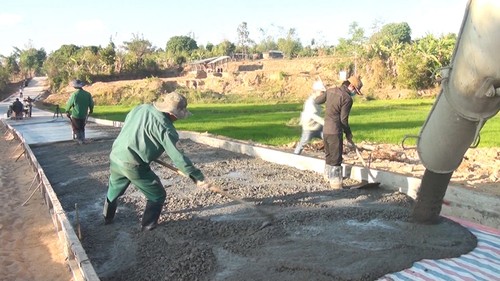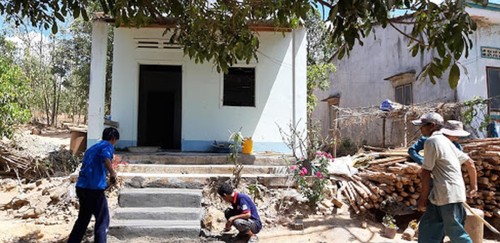 All the roads in Dak Ro Wa commune, Kon Tum city, are paved. (Photo: VOV) All the roads in Dak Ro Wa commune, Kon Tum city, are paved. (Photo: VOV) |
Dak Ro Wa commune has 5 hamlets with 860 households and 2,600 people, who used to grow low-profit crops like rice, maize, potatoes, and cassava. They had a high poverty rate. But their lives began to improve when the commune implemented the new-style rural development program.
Concrete roads have been built in Kon Jo Dri village on the other side of the Dak Bla River across the Kon Klor suspension bridge, the longest and most beautiful suspension bridge in the Central Highlands. The number of coffee and fruit trees, terraced fields, and highly profitable farms is growing.
Villager A Mim says that, thanks to the new-style rural development program, many households in Kon Jo Dri village now earn between 6,600 and 7,900 USD a year from cultivation or breeding.
A Mim recalls, "New-style rural development has meant a better economy and higher incomes. My family has taken advantage of preferential loans to invest in growing coffee and litsea and raising cows and pigs.”
“We have re-invested the income. Step by step my family has escaped poverty. Now we can build a new house, buy a car, and afford our children’s education. Now that we’ve become better off, we can help other households and get them to follow suit. Building a new-style rural area means all villagers can grow together," Mim said.
 After a decade to implement the new-style rural development program, there have been no thatched houses in Dak Ro Wa commune. (Photo: VOV) After a decade to implement the new-style rural development program, there have been no thatched houses in Dak Ro Wa commune. (Photo: VOV) |
Kon Ko Tu, another village in Dak Ro Wa commune connected to Kon Tum city by the Kon Klor bridge, has changed dramatically since implementing the new-style rural development program.
Villager Y Maih says it now takes very little time to go from the village to the commune center thanks to the new concrete road.
Y Maih is proud that her family has contributed to the change, saying, "My family donated dozens of square meters of land for the new road.”
Y Maih told us villagers all agree that this is a wise policy on the part of the Party and State as “The new road has made it easy for vehicles to carry farm produce to market and children to school, even on rainy days."
Doan Van Hau, Dak Ro Wa commune’s chairman, said the local administration has outlined detailed plans to realize the new-style rural building program. Everyone has been mobilized to participate.
Since 2011 the commune has spent 4.4 million USD on rural building, 60% of it contributed by local people. 35 km of roads in Dak Ro Wa commune have been asphalted, three transformer stations have been built, and connection to the national power grid has been completed.
There are no more dilapidated houses. There remain only 86 poor households out of total 860. Last year, the average income per capita was nearly 1,800 USD.
"The commune has completed 12 of 19 criteria. This year we plan to fulfill 3 more criteria in traffic, production organization, and environment. We’ve created a roadmap for the next few years and disseminated it to the people and agencies to work toward completing the remaining criteria. We hope to complete the program by early 2023," said Hau.